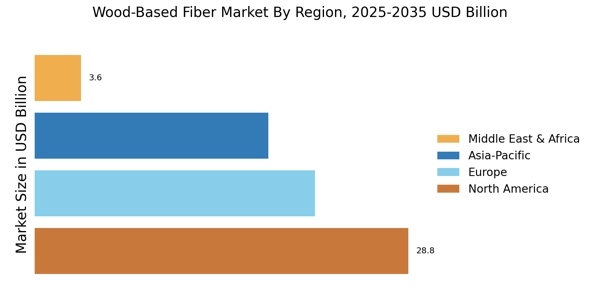Technological Innovations
Technological advancements play a crucial role in shaping the Wood-Based Fiber Market. Innovations in processing techniques, such as improved pulping methods and fiber extraction technologies, enhance the quality and efficiency of wood-based fibers. For instance, the introduction of enzymatic treatments has been shown to increase yield and reduce energy consumption. Furthermore, the integration of digital technologies in supply chain management is streamlining operations, thereby reducing costs. The market is expected to witness a compound annual growth rate of 4.5% through 2027, driven by these technological improvements. As manufacturers adopt these innovations, the Wood-Based Fiber Market is likely to experience enhanced competitiveness and growth.
Sustainability Initiatives
The increasing emphasis on sustainability is a pivotal driver for the Wood-Based Fiber Market. As consumers and businesses alike prioritize eco-friendly products, the demand for wood-based fibers, which are renewable and biodegradable, is likely to rise. This shift is reflected in the growing market for sustainable textiles, projected to reach USD 8.25 billion by 2025. Companies are investing in sustainable sourcing practices, which not only enhance their brand image but also align with regulatory frameworks aimed at reducing carbon footprints. The Wood-Based Fiber Market is thus positioned to benefit from this trend, as manufacturers adapt their processes to meet the rising demand for environmentally responsible products.
Rising Demand for Bio-Based Products
The growing consumer preference for bio-based products is a significant driver for the Wood-Based Fiber Market. As awareness of the environmental impact of synthetic fibers increases, consumers are gravitating towards natural alternatives. This trend is evident in the textile sector, where the demand for organic cotton and other bio-based fibers is surging. The market for bio-based textiles is projected to expand at a rate of 5.2% annually, indicating a robust shift towards sustainable materials. Consequently, manufacturers in the Wood-Based Fiber Market are likely to capitalize on this trend by developing innovative products that meet consumer expectations for sustainability and performance.
Expanding Applications in Diverse Industries
The versatility of wood-based fibers is a key driver for the Wood-Based Fiber Market. These fibers are increasingly being utilized in various sectors, including textiles, construction, and automotive industries. For instance, the use of wood-based fibers in composite materials for automotive applications is gaining traction due to their lightweight and strength properties. The construction sector is also adopting wood-based fibers for insulation and paneling, driven by the need for sustainable building materials. This diversification of applications is expected to propel the market forward, with projections indicating a potential market size of USD 12 billion by 2028. As industries continue to explore the benefits of wood-based fibers, the Wood-Based Fiber Market is likely to experience robust growth.
Regulatory Support for Sustainable Practices
Regulatory frameworks promoting sustainable practices are increasingly influencing the Wood-Based Fiber Market. Governments are implementing policies that encourage the use of renewable resources and penalize environmentally harmful practices. For example, initiatives aimed at reducing plastic waste are driving industries to seek alternatives, such as wood-based fibers. This regulatory support not only fosters innovation but also creates a favorable market environment for sustainable products. The Wood-Based Fiber Market stands to gain from these policies, as they incentivize manufacturers to invest in sustainable sourcing and production methods, ultimately enhancing market growth.


















Leave a Comment